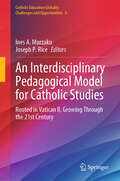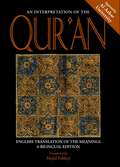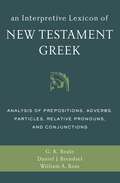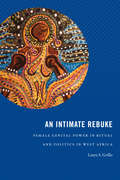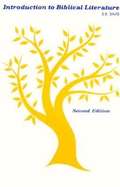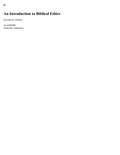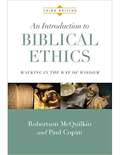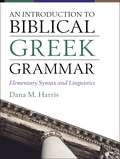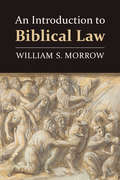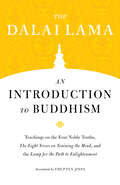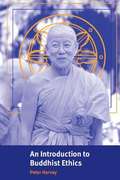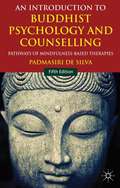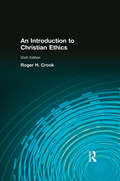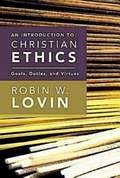- Table View
- List View
An Interdisciplinary Pedagogical Model for Catholic Studies: Rooted in Vatican II, Growing Through the 21st Century (Catholic Education Globally: Challenges and Opportunities #4)
by Ines A. Murzaku Joseph P. RiceThis book offers a vision of an integrated Humanities curriculum, potentiated by the depth and diversity of perspectives that Catholic Studies contributes to both Catholic and secular universities. The result, inspired in various magisterial documents, is a more profound, relevant, and enduring college learning experience. It considers Catholic Studies as a response to the rich legacy of Vatican II, and its opening to contemporary culture, as it is expressed in Catholic education. It answers the dual call of the Declaration on Christian Education Gravissimum Educationis (GE) for cooperation and collaboration among Catholic institutions of higher learning, and among faculty of the different scholarly disciplines. This book displays the interdisciplinary breadth and disciplinary depth of Catholic Studies, while providing a window into the practical insights gained by experts in research, program design, and teaching in a flourishing Catholic Studies program that has inspired the founding of the Seton Hall University core curriculum. Complemented by the contributions of Catholic Studies experts from outside Seton Hall, this book serves as a pedagogical model for researchers and educators to consider and emulate, nationally and internationally, an interdisciplinary Catholic Studies model as a way to recuperate theology; stop the siege of the humanities; and teach humanities in contact and communication with other disciplines, including STEM and other vocation-oriented fields. In this overall context, this book serves as a guide and a reference for new and established programs of Catholic Studies, nationally and internationally. It seeks to extend a conversation, in the style of a symposium, to campuses and cultural contexts in the United States and internationally.
An Interpretation of Christian Ethics
by Reinhold NiebuhrThis addition to Westminster John Knox Press's Library of Theological Ethics series brings one of Reinhold Niebuhr's classic works back into print. This 1935 book answered some of the theological questions raised by Moral Man and Immoral Society (1932) and articulated for the first time Niebuhr's theological position on many issues. The introduction by ethicist Edmund N. Santurri sets the work into historical and theological context and also assesses the viability of some of Niebuhr's positions for theology and ethics today.
An Interpretation of Friends Worship (Start Classics)
by Jean ToomerReligious text written by American novelist and poet, Jean Toomer
An Interpretation of the Qur'an: English Translation of the Meanings
by Majid FakhryA comprehensive and accurate rending of the Qur'an into modern English, approved by Al-Azhar University in CairoTo followers of Islam, the Qur'an is the literal word of God, revealed through Muhammad, the last of the line of prophets, containing all that is necessary to lead a life of righteousness. This new bilingual edition, approved by Al-Azhar University, the chief center of Islamic and Arabic learning in the world, offers a comprehensive and accurate rendering of the Qur'an into modern English. The clear, rigorous translation, one of the only English translations available by a native Arabic speaker, is laid out here in dual column format directly opposing the Arabic text to allow the reader to make careful verse by verse comparisons. • Approved by Al-Azhar University, Cairo • Easy-to-read translation into modern English • Index of surahs (chapters)• English and Arabic headers • Verse numbers within text in English and Arabic • Explanatory footnotes in English
An Interpretive Lexicon of New Testament Greek: Analysis of Prepositions, Adverbs, Particles, Relative Pronouns, and Conjunctions
by Daniel Joseph Brendsel Gregory K. Beale William A. RossThis Interpretive Lexicon has two primary functions aimed at facilitating the exegetical and translational task, namely as a lexicon and also as an interpretive handbook. First, this book lists the vast majority of Greek prepositions, adverbs, particles, relative pronouns, conjunctions, and other connecting words that are notorious for being some of the most difficult words to translate. For each word included, page references are given for several major lexical resources where the user can quickly go to examine the nuances and parameters of the word for translation options. This book will save considerable time for students of the Greek New Testament text. For example, for the Greek preposition en (occurs 2,750 times in the New Testament) covers four pages of small print in the Bauer-Danker lexicon (BDAG). But Interpretive Lexicon digests those pages in just a few lines, with the page numbers and section references given for A Greek-English Lexicon of the New Testament and Other Early Christian Literature, 3rd Edition (BDAG, ’00) and 2nd Edition (BAGD, ’79), Greek Grammar Beyond the Basics (Daniel B. Wallace), and Prepositions and Theology in the Greek New Testament (Murray J. Harris). Thus, the translation options can be analyzed quickly. For words with a lower frequency of occurrence and fewer translation options, this book may be sufficient in itself as a lexicon. Secondly, these prepositions, conjunctions, adverbs, and connecting words in Greek, as in every language, function as explicit discourse-level markers that are essential for ascertaining the main point(s) of a passage. Therefore, this Interpretive Lexicon also evaluates the discourse function(s) of each word that is defined and catalogued, and categorizes its semantic range into defined logical relationships. This feature of the lexicon adds an interpretive element, since translation must include interpretation, at least on a linguistic level. For example, en may be translated in many ways, but those ways are categorized broadly in this book into relationships such as locative (in, among, on), means-end (with, by), grounds (because, on account of), temporal (while, at), and so on. This interpretive feature of the book is tremendously helpful for the exegetical process, allowing for the translator to closely follow the logical flow of the text with greater efficiency. This Interpretive Lexicon is thus a remarkable resource for student, pastor, and scholar alike.
An Intimate Rebuke: Female Genital Power in Ritual and Politics in West Africa (Religious Cultures of African and African Diaspora People)
by Laura S. GrilloThroughout West African societies, at times of social crises, postmenopausal women—the Mothers—make a ritual appeal to their innate moral authority. The seat of this power is the female genitalia. Wielding branches or pestles, they strip naked and slap their genitals and bare breasts to curse and expel the forces of evil. In An Intimate Rebuke Laura S. Grillo draws on fieldwork in Côte d’Ivoire that spans three decades to illustrate how these rituals of Female Genital Power (FGP) constitute religious and political responses to abuses of power. When deployed in secret, FGP operates as spiritual warfare against witchcraft; in public, it serves as a political activism. During Côte d’Ivoire’s civil wars FGP challenged the immoral forces of both rebels and the state. Grillo shows how the ritual potency of the Mothers’ nudity and the conjuration of their sex embodies a moral power that has been foundational to West African civilization. Highlighting the remarkable continuity of the practice across centuries while foregrounding the timeliness of FGP in contemporary political resistance, Grillo shifts perspectives on West African history, ethnography, comparative religious studies, and postcolonial studies.
An Introduction To Biblical Literature
by O. B. Davis Alexandria D. Di PentimaThis text contains a generous portion of the King James Version of the Old Testament in an exceptionally readable format--that of the highly praised Dartmouth Bible. Organized to give students a comprehensive introduction to the Bible as one of the glories of English literature, its purpose is to help return the Bible to a central place in our continuing education in literature and language.
An Introduction To The New Testament
by D. A. Carson Douglas J. MooAn updated and expanded edition of a standard textbook on the New Testament for first- and second-year seminary students.
An Introduction to Akkadian Literature: Contexts and Content
by Alan Charles LenziThis book initiates the reader into the study of Akkadian literature from ancient Babylonia and Assyria. With this one relatively short volume, the novice reader will develop the literary competence necessary to read and interpret Akkadian texts in translation and will gain a broad familiarity with the major genres and compositions in the language.The first part of the book presents introductory discussions of major critical issues, organized under four key rubrics: tablets, scribes, compositions, and audiences. Here, the reader will find descriptions of the tablets used as writing material; the training scribes received and the institutional contexts in which they worked; the general characteristics of Akkadian compositions, with an emphasis on poetic and literary features; and the various audiences or users of Akkadian texts. The second part surveys the corpus of Akkadian literature defined inclusively, canvasing a wide spectrum of compositions. Legal codes, historical inscriptions, divinatory compendia, and religious texts have a place in the survey alongside narrative poems, such as the Epic of Gilgamesh, Enuma elish, and Babylonian Theodicy. Extensive footnotes and a generous bibliography guide readers who wish to continue their study.Essential for students of Assyriology, An Introduction to Akkadian Literature will also prove useful to biblical scholars, classicists, Egyptologists, ancient historians, and literary comparativists.
An Introduction to Akkadian Literature: Contexts and Content
by Alan LenziThis book initiates the reader into the study of Akkadian literature from ancient Babylonia and Assyria. With this one relatively short volume, the novice reader will develop the literary competence necessary to read and interpret Akkadian texts in translation and will gain a broad familiarity with the major genres and compositions in the language.The first part of the book presents introductory discussions of major critical issues, organized under four key rubrics: tablets, scribes, compositions, and audiences. Here, the reader will find descriptions of the tablets used as writing material; the training scribes received and the institutional contexts in which they worked; the general characteristics of Akkadian compositions, with an emphasis on poetic and literary features; and the various audiences or users of Akkadian texts. The second part surveys the corpus of Akkadian literature defined inclusively, canvasing a wide spectrum of compositions. Legal codes, historical inscriptions, divinatory compendia, and religious texts have a place in the survey alongside narrative poems, such as the Epic of Gilgamesh, Enuma elish, and Babylonian Theodicy. Extensive footnotes and a generous bibliography guide readers who wish to continue their study.Essential for students of Assyriology, An Introduction to Akkadian Literature will also prove useful to biblical scholars, classicists, Egyptologists, ancient historians, and literary comparativists.
An Introduction to Biblical Ethics: B&H Studies in Christian Ethics
by David W. Jones Daniel HeimbachThis book serves as an introduction to the field of biblical ethics, a subcategory of the discipline of moral theology. It differs from moral philosophy in that biblical ethics is distinctively Christian, and it is more specific than Christian ethics proper because it specifically focuses upon the application of the moral law -- as it is revealed in Scripture -- to daily living. <p><p>Introduction to Biblical Ethics explains the nature, relevancy, coherency, and structure of the moral law as revealed throughout the Bible. In addition to covering the foundational elements of biblical ethics, major issues investigated in this volume include: different types of law in Scripture, the relationship between the law and the gospel, and issues related to the prospect of conflicting moral absolutes. <p><p>Additionally, after a discussion of ethical methodology, and using the Ten Commandments as a moral rubric, author David W. Jones explores the place of the moral law in the lives of believers. In the final chapters, the events surrounding the giving of the Decalogue are surveyed, and the application of each of the Ten Commandments to Christian living is explored.
An Introduction to Biblical Ethics: Walking in the Way of Wisdom
by Paul Copan Robertson McQuilkinWhat should we do or not do? What attitudes, behavior and qualities are good? Can we be good without God? What is the highest good, the purpose of human existence? These are the questions the study of ethics seeks to answer. Unlike many approaches to ethics, this book foundationally turns to Scripture, going only as far as Scripture itself goes. The result is an overview of biblical ethics that not only addresses the life of love and wisdom to be lived out by Christians as virtuous individuals, but also as Christians in community, in society and in a world of God?s creation. Key preliminary considerations of love, law, sin and virtue are given their due in this thoroughly revised and updated text. The bulk of the work is then organized around the Ten Commandments and ethical themes springing from them—loving God (commandments 1-4) and loving others (commandments 6-10). This new edition includes added material on ethical alternatives such as relativism, social contract, utilitarianism and evolutionary ethics the seven deadly sins as well as the cardinal virtues vs. theological virtues end-of-life ethics, stem-cell research, animal rights, sexuality, genetics and technology, and other bioethical issues such as plastic surgery and surrogate motherhood technology and its depersonalizing effects as well as helping the poor the church?s engagement in society and how Christians can make a difference in the media. McQuilkin and Copan stay focused on how we are fulfilling the purposes of God for our lives—a will that is for our good and our well-being. This comprehensive study is the place to begin on the journey of living wisely, faithfully and obediently.
An Introduction to Biblical Ethics: Walking in the Way of Wisdom
by Paul Copan Robertson McQuilkinWhat should we do or not do? What attitudes, behavior and qualities are good? Can we be good without God? What is the highest good, the purpose of human existence? These are the questions the study of ethics seeks to answer. Unlike many approaches to ethics, this book foundationally turns to Scripture, going only as far as Scripture itself goes. The result is an overview of biblical ethics that not only addresses the life of love and wisdom to be lived out by Christians as virtuous individuals, but also as Christians in community, in society and in a world of God?s creation. Key preliminary considerations of love, law, sin and virtue are given their due in this thoroughly revised and updated text. The bulk of the work is then organized around the Ten Commandments and ethical themes springing from them―loving God (commandments 1-4) and loving others (commandments 6-10). This new edition includes added material on <P><P> <li>ethical alternatives such as relativism, social contract, utilitarianism and evolutionary ethics <li>the seven deadly sins as well as the cardinal virtues vs. theological virtues <li>end-of-life ethics, stem-cell research, animal rights, sexuality, genetics and technology, and other bioethical issues such as plastic surgery and surrogate motherhood <li>technology and its depersonalizing effects as well as helping the poor <li>the church's engagement in society and how Christians can make a difference in the media. <P><P>McQuilkin and Copan stay focused on how we are fulfilling the purposes of God for our lives―a will that is for our good and our well-being. This comprehensive study is the place to begin on the journey of living wisely, faithfully and obediently.
An Introduction to Biblical Greek Grammar: Elementary Syntax and Linguistics
by Dana M. HarrisAn Introduction to Biblical Greek Grammar focuses on the linguistic and syntactic elements of Koine Greek to equip learners for accurate interpretation. Drawing upon twenty years of Greek teaching experience and the latest developments in linguistics and syntax, Harris introduces students to basic linguistic concepts and categories necessary for grasping Greek in ways that are clear and intuitive. This solid foundation enables students first to internalize key concepts, then to apply and build upon them as more complex ideas are introduced.Several features are specifically designed to aid student's learning:Key concepts are graphically coded to offer visual reinforcement of explanations and to facilitate learning forms and identifying their functionsKey concepts are followed by numerous examples from the Greek New TestamentStudents learn how to mark Greek texts so that they can begin to "see" the syntax, identify the boundaries of syntactic units, and construct syntactic outlines as part of their preaching or teaching preparationFour integrative chapters, roughly corresponding to the midterms and final exams of a two-semester sequence, summarize material to date and reinforce key concepts. Here students are also introduced to exegetical and interpretive concepts and practices that they will need for subsequent Greek studies and beyond."Going Deeper" and "For the Curious" offer supplemental information for students interested in learning more or in moving to advanced language study.The accompanying workbook and video lectures (both sold separately) reinforce key concepts through additional contact with the material from each chapter of the grammar. All exercises in the workbook are taken from the Greek New Testament and the Septuagint and include extensive syntactical and exegetical notes to aid students.
An Introduction to Biblical Greek Workbook: Elementary Syntax and Linguistics
by Dana M. Harris Chi-ying WongThis workbook is designed to accompany An Introduction to Biblical Greek Grammar, which focuses on the linguistic and syntactic elements of Koine Greek to equip learners for accurate interpretation. It reinforces key concepts student learn through parsing and translation exercises for each chapter. All texts are taken from the Greek New Testament and the Septuagint and include extensive syntactical and exegetical notes to aid students.In An Introduction to Biblical Greek Grammar, author Dana Harris draws upon twenty years of Greek teaching experience and the latest developments in linguistics and syntax to introduce students to basic linguistic concepts and categories necessary for grasping Greek in ways that are clear and intuitive. This solid foundation enables students first to internalize key concepts, then to apply and build upon them as more complex ideas are introduced.Several features are specifically designed to aid student's learning:Key concepts are graphically coded to offer visual reinforcement of explanations and to facilitate learning forms and identifying their functionsKey concepts are followed by numerous examples from the Greek New TestamentStudents learn how to mark Greek texts so that they can begin to "see" the syntax, identify the boundaries of syntactic units, and construct syntactic outlines as part of their preaching or teaching preparationFour integrative chapters, roughly corresponding to the midterms and final exams of a two-semester sequence, summarize material to date and reinforce key concepts. Here students are also introduced to exegetical and interpretive concepts and practices that they will need for subsequent Greek studies and beyond."Going Deeper" and "For the Curious" offer supplemental information for students interested in learning more or in moving to advanced language study.
An Introduction to Biblical Law
by William S. MorrowInformed, accessible textbook on law collections in the Pentateuch In this book William Morrow surveys four major law collections in Exodus–Deuteronomy and shows how they each enabled the people of Israel to create and sustain a community of faith. Treating biblical law as dynamic systems of thought facilitating ancient Israel's efforts at self-definition, Morrow describes four different social contexts that gave rise to biblical law: (1) Israel at the holy mountain (the Ten Commandments); (2) Israel in the village assembly (Exodus 20:22–23:19); (3) Israel in the courts of the Lord (priestly and holiness rules in Exodus, Leviticus, and Numbers); and (4) Israel in the city (Deuteronomy). Including forthright discussion of such controversial subjects as slavery, revenge, gender inequality, religious intolerance, and contradictions between bodies of biblical law, Morrow's study will help students and other serious readers make sense out of texts in the Pentateuch that are often seen as obscure.
An Introduction to Biblical Law
by William S. MorrowInformed, accessible textbook on law collections in the Pentateuch In this book William Morrow surveys four major law collections in Exodus–Deuteronomy and shows how they each enabled the people of Israel to create and sustain a community of faith. Treating biblical law as dynamic systems of thought facilitating ancient Israel's efforts at self-definition, Morrow describes four different social contexts that gave rise to biblical law: (1) Israel at the holy mountain (the Ten Commandments); (2) Israel in the village assembly (Exodus 20:22–23:19); (3) Israel in the courts of the Lord (priestly and holiness rules in Exodus, Leviticus, and Numbers); and (4) Israel in the city (Deuteronomy). Including forthright discussion of such controversial subjects as slavery, revenge, gender inequality, religious intolerance, and contradictions between bodies of biblical law, Morrow's study will help students and other serious readers make sense out of texts in the Pentateuch that are often seen as obscure.
An Introduction to Buddhism
by Peter HarveyThis extensively revised and updated second edition draws upon recent scholarship to present a comprehensive overview of the development of Buddhism in Asia and the West. Detailed references to secondary literature and a section on web resources make it ideal for students of religion, philosophy or Asian studies.
An Introduction to Buddhism (Core Teachings of Dalai Lama)
by The Dalai LamaThe "Core Teachings of the Dalai Lama" series begins with this small book of teachings by His Holiness, the perfect introduction to traditional Tibetan Buddhist thought and practice.There is no one more suited to introduce beginners—and remind seasoned practitioners— of the fundamentals of Tibetan Buddhism than His Holiness the Dalai Lama. Speaking to an audience of Western students, the Dalai Lama shows us how to apply basic Buddhist principles to our day-to-day lives. Starting with the very foundation of Buddhism, the Four Noble Truths, he provides the framework for understanding the Buddha’s first teachings on suffering, happiness, and peace. He follows with commentary on two of Buddhism’s most profound texts: The Eight Verses on Training the Mind and Atisha’s Lamp for the Path to Enlightenment, often referring to the former as one of his main sources of inspiration for the practice of compassion. With clear, accessible language and the familiar sense of humor that infuses nearly all of his work, the Dalai Lama invites us all to develop innermost awareness, a proper understanding of the nature of reality, and heartfelt compassion for all beings.This book was previously published under the title Lighting the Way.
An Introduction to Buddhist Ethics: Foundations, Values and Issues
by Peter HarveyThis systematic introduction to Buddhist ethics is aimed at anyone interested in Buddhism, including students, scholars and general readers. Peter Harvey is the author of the acclaimed Introduction to Buddhism (Cambridge, 1990), and his new book is written in a clear style, assuming no prior knowledge. At the same time it develops a careful, probing analysis of the nature and practical dynamics of Buddhist ethics in both its unifying themes and in the particularities of different Buddhist traditions. The book applies Buddhist ethics to a range of issues of contemporary concern: humanity's relationship with the rest of nature; economics; war and peace; euthanasia; abortion; the status of women; and homosexuality. Professor Harvey draws on texts of the main Buddhist traditions, and on historical and contemporary accounts of the behaviour of Buddhists, to describe existing Buddhist ethics, to assess different views within it, and to extend its application into new areas.
An Introduction to Buddhist Psychology and Counselling
by Padmasiri De SilvaThis book, now in its fifth edition, provides a comprehensive introduction to Buddhist psychology and counselling, exploring key concepts in psychology and practical applications in mindfulness-based counselling techniques using Buddhist philosophy of mind, psychology, ethics and contemplative methods.
An Introduction to Catholic Ethics since Vatican II
by Andrew KimThis introduction provides a comprehensive overview of the development of Catholic ethics in the wake of the Second Vatican Council (1962–5), an event widely considered crucial to the reconciliation of the Catholic Church and the modern world. Andrew Kim investigates Catholic responses to questions of moral theology in all four principal areas: Catholic social teaching, natural law, virtue ethics, and bioethics. In addition to discussing contemporary controversies surrounding abortion, contraception, labor rights, exploitation of the poor, and just war theory, he explores the historical sources of the Catholic worldview. Beginning with the moral vision revealed through the person of Jesus Christ and continuing with elaborations on this vision from figures such as Augustine and Aquinas, this volume elucidates the continuity of the Catholic moral tradition. Its balance of complexity and accessibility makes it an ideal resource for both students of theology and general readers.
An Introduction to Christian Ethics (2-downloads)
by Roger H CrooksAn Introduction to Christian Ethics uses a Christian approach while encouraging students to consider a variety of current ethical issues and apply relevant biblical and theological concepts to these issues. The main goal of the text is to acquaint students with both the field of ethics in general and varieties of Christian ethical systems in particular. Learning Goals Upon completing this book, readers will be able to use a Christian method of making moral decisions and view issues from a Christian perspective.
An Introduction to Christian Ethics: Goals, Duties, and Virtues
by Robin W. LovinA few years ago, the first distinction that ethicists drew was the line between Christian ethics and philosophical ethics. However, in our global context, Christian ethicists must now, in addition, compare and contrast various ethics. Christian ethics has become increasingly multivocal not only because of a plurality of faiths but also because of a plurality of Christianities. In light of these new realities, this book will introduce Christian ethics. It will lay out history, methods, and basic principles every student must know. The author also will include case studies for further explanation and application.
An Introduction to Christian Philosophical Theology: Faith Seeking Understanding
by Stephen T. Davis Eric T. YangAn accessible introduction to Christian philosophical theologyPhilosophical or analytic theology seeks to employ philosophical tools while studying topics in Christian theology and examining the logical consistency or intelligibility of some of the key doctrines of the Christian faith. In this accessible primer, An Introduction to Christian Philosophical Theology, authors Stephen T. Davis and Eric T. Yang first explain the scope, relevance, and value of philosophical theology and then applies its conceptual tools to examine each of the core Christian doctrines:Revelation and ScriptureThe TrinityThe IncarnationRedemption and the atonement,Resurrection and life after deathThe final chapter briefly addresses some additional theological issues including petitionary prayer, eschatology, and original sin.Designed for beginning students and non-specialists this guide provides the ideal entry point for not only understanding what philosophical theology is but also for how it can provide valuable insights for how we think about the core doctrines of the Christian faith.
